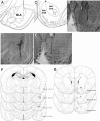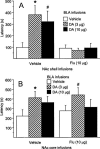Modulation of memory consolidation by the basolateral amygdala or nucleus accumbens shell requires concurrent dopamine receptor activation in both brain regions
- PMID: 15930508
- PMCID: PMC1142458
- DOI: 10.1101/lm.93205
Modulation of memory consolidation by the basolateral amygdala or nucleus accumbens shell requires concurrent dopamine receptor activation in both brain regions
Abstract
Previous findings indicate that the basolateral amygdala (BLA) and the nucleus accumbens (NAc) interact in influencing memory consolidation. The current study investigated whether this interaction requires concurrent dopamine (DA) receptor activation in both brain regions. Unilateral, right-side cannulae were implanted into the BLA and the ipsilateral NAc shell or core in male Sprague-Dawley rats ( approximately 300 g). One week later, the rats were trained on an inhibitory avoidance (IA) task and, 48 h later, they were tested for retention. Drugs were infused into the BLA and NAc shell or core immediately after training. Post-training intra-BLA infusions of DA enhanced retention, as assessed by latencies to enter the shock compartment on the retention test. Infusions of the general DA receptor antagonist cis-Flupenthixol (Flu) into the NAc shell (but not the core) blocked the memory enhancement induced by the BLA infusions of DA. In the reverse experiment, post-training intra-NAc shell infusions of DA enhanced retention and Flu infusions into the BLA blocked the enhancement. These findings indicate that BLA modulation of memory consolidation requires concurrent DA receptor activation in the NAc shell but not the core. Similarly, NAc shell modulation of memory consolidation requires concurrent DA receptor activation in the BLA. Together with previous findings, these results suggest that the dopaminergic innervation of the BLA and NAc shell is critically involved in the modulation of memory consolidation.
Figures



Similar articles
-
Memory enhancement induced by post-training intrabasolateral amygdala infusions of beta-adrenergic or muscarinic agonists requires activation of dopamine receptors: Involvement of right, but not left, basolateral amygdala.Learn Mem. 2005 Sep-Oct;12(5):527-32. doi: 10.1101/lm.97405. Learn Mem. 2005. PMID: 16204205 Free PMC article.
-
Post-training intrabasolateral amygdala infusions of dopamine modulate consolidation of inhibitory avoidance memory: involvement of noradrenergic and cholinergic systems.Eur J Neurosci. 2004 Nov;20(10):2804-10. doi: 10.1111/j.1460-9568.2004.03744.x. Eur J Neurosci. 2004. PMID: 15548223
-
Identification of a dopamine receptor-mediated opiate reward memory switch in the basolateral amygdala-nucleus accumbens circuit.J Neurosci. 2011 Aug 3;31(31):11172-83. doi: 10.1523/JNEUROSCI.1781-11.2011. J Neurosci. 2011. PMID: 21813678 Free PMC article.
-
Opposing roles of nucleus accumbens core and shell dopamine in the modulation of limbic information processing.J Neurosci. 2011 Apr 20;31(16):6001-7. doi: 10.1523/JNEUROSCI.6588-10.2011. J Neurosci. 2011. PMID: 21508225 Free PMC article.
-
Basolateral amygdala modulation of the nucleus accumbens dopamine response to stress: role of the medial prefrontal cortex.Eur J Neurosci. 2003 Mar;17(6):1287-95. doi: 10.1046/j.1460-9568.2003.02560.x. Eur J Neurosci. 2003. PMID: 12670317
Cited by
-
Fornix deep brain stimulation circuit effect is dependent on major excitatory transmission via the nucleus accumbens.Neuroimage. 2016 Mar;128:138-148. doi: 10.1016/j.neuroimage.2015.12.056. Epub 2016 Jan 11. Neuroimage. 2016. PMID: 26780572 Free PMC article.
-
Interacting brain systems modulate memory consolidation.Neurosci Biobehav Rev. 2012 Aug;36(7):1750-62. doi: 10.1016/j.neubiorev.2011.11.001. Epub 2011 Nov 7. Neurosci Biobehav Rev. 2012. PMID: 22085800 Free PMC article. Review.
-
The comparative distributions of the monoamine transporters in the rodent, monkey, and human amygdala.Brain Struct Funct. 2008 Sep;213(1-2):73-91. doi: 10.1007/s00429-008-0176-2. Epub 2008 Feb 19. Brain Struct Funct. 2008. PMID: 18283492 Free PMC article. Review.
-
A systematic review of the neurobiological aspects of memory in the aging process.Dement Neuropsychol. 2011 Oct-Dec;5(4):310-321. doi: 10.1590/S1980-57642011DN05040009. Dement Neuropsychol. 2011. PMID: 29213758 Free PMC article. Review.
-
D2 Receptors and Sodium Ion Channel Blockades of the Basolateral Amygdala Attenuate Lithium Chloride-Induced Conditioned Taste Aversion Applying to Cancer Chemotherapy Nausea and Vomiting.Brain Sci. 2023 Apr 21;13(4):697. doi: 10.3390/brainsci13040697. Brain Sci. 2023. PMID: 37190662 Free PMC article.
References
-
- Barrot, M., Marinelli, M., Abrous, D.N., Rouge-Pont, F., Le Moal, M., and Piazza, P.V. 2000. The dopaminergic hyper-responsiveness of the shell of the nucleus accumbens is hormone-dependent. Eur. J. Neurosci. 12: 973-979. - PubMed
-
- Carr, G.D. and White, N.M. 1983. Conditioned place preference from intra-accumbens but not intra-caudate amphetamine injections. Life Sci. 33: 2551-2557. - PubMed
-
- Christie, M.J., Summers, R.J., Stephenson, J.A., Cook, C.J., and Beart, P.M. 1987. Excitatory amino acid projections to the nucleus accumbens septi in the rat: A retrograde transport study utilizing d[3h]aspartate and [3h]gaba. Neuroscience. 22: 425-439. - PubMed
-
- Fallon, J.H. and Loughlin, S.E. 1995. Substantia nigra. In The rat nervous system (ed. G. Paxinos), pp. 215-237. Academic Press, San Diego, CA.
-
- Floresco, S.B., Yang, C.R., Phillips, A.G., and Blaha, C.D. 1998. Basolateral amygdala stimulation evokes glutamate receptor-dependent dopamine efflux in the nucleus accumbens of the anaesthetized rat. Eur. J. Neurosci. 10: 1241-1251. - PubMed
Publication types
MeSH terms
Substances
Grants and funding
LinkOut - more resources
Full Text Sources
Medical
